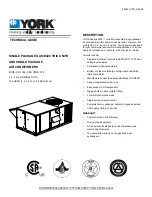
Installation Electrical
28
RT-SVX34F-EN
Disconnect Switch Sizing (DSS)
Calculation A. - YC*, TC*, and TE* Units:
DSS = 1.15 X (LOAD1 + LOAD2 + LOAD4)
For TE* units, use calculations A and B.
Calculation B. - TE* Units:
DSS = 1.15 X (LOAD3 + Supply Fan FLA + Exhaust
Fan FLA).
Use the larger value of calculations A or B to size the
electrical disconnect switch.
Low Voltage Wiring
An overall layout of the various control options available
for a Constant Volume application is illustrated in
Figure 19, p. 30
and
Figure 20, p. 31
illustrates the various
control options for a Variable Air Volume application. The
required number of conductors for each control device are
listed in the illustration.
A typical field connection diagram for the sensors and
other options are shown in the following section “Remote
Panels and Sensors”. These diagrams are representative of
standard applications and are provided for general
reference only. Always refer to the wiring diagram that
shipped with the unit for specific electrical schematic and
connection information.
Note:
All field wiring must conform to NEC guidelines as
well as state and local codes.
Control Power Transformer
The 24 volt control power transformers are equipped with
internal circuit breakers. They are to be used only with the
accessories called out in this manual. If a circuit breaker
trips, be sure to turn off all power to the unit before
attempting to reset it.
On units equipped with the VFD option, an additional
control power transformer is used. The secondary is
protected with fuses. Should the fuse blow, be sure to turn
off all power to the unit before attempting to replace it.
Field Installed AC Control Wiring
Before installing any connecting wiring, refer to
Table 13,
p. 28
for conductor sizing guidelines and;
•
Use copper conductors unless otherwise specified.
•
Ensure that the AC control voltage wiring between
the controls and the unit's termination point does
not exceed three (3) ohms/conductor for the length
of the run.
Note:
Resistance in excess of 3 ohms per conductor may
cause component failure due to insufficient AC
voltage supply.
•
Refer to dimensional information beginning with
Figure 1, p. 13
for the electrical access locations
provided on the unit.
•
Do not run the AC low voltage wiring in the same
conduit with the high voltage power supply wiring.
Be sure to check all loads and conductors for grounds,
shorts, and miswiring. After correcting any discrepancies,
reset the circuit breakers by pressing the black button
located on the left side of the transformer.
WARNING
Hazardous Voltage!
Disconnect all electric power, including remote
disconnects before servicing. Follow proper lockout/
tagout procedures to ensure the power can not be
inadvertently energized. Failure to disconnect power
before servicing could result in death or serious injury.
WARNING
Proper Field Wiring and Grounding
Required!
All field wiring MUST be performed by qualified
personnel. Improperly installed and grounded field
wiring poses FIRE and ELECTROCUTION hazards. To
avoid these hazards, you MUST follow requirements for
field wiring installation and grounding as described in
NEC and your local/state electrical codes. Failure to
follow code could result in death or serious injury.
NOTICE:
Use Copper Conductors Only!
Unit terminals are not designed to accept other types of
conductors. Failure to use copper conductors could
result in equipment damage.
Table 13. AC conductors
Distance from unit to control
Recommended wire size
000-460 feet
18 gauge
461-732 feet
16 gauge
733-1000 feet
14 gauge
















































